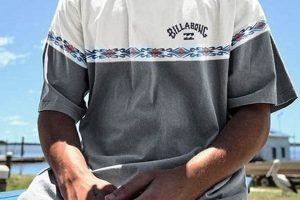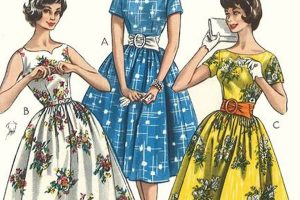Informational tags affixed to apparel from a prior era, typically exceeding two decades in age, serve as crucial identifiers. These markers denote the manufacturer, fabric composition, care instructions, and size. As an example, a woven tag stitched into the neckline of a dress from the 1960s bearing a brand name now defunct exemplifies this category.
These identifiers provide valuable insight into the garment’s origin, manufacturing practices, and the era in which it was produced. They aid in authentication, dating, and understanding the quality of materials utilized. The presence of a union label, for instance, can pinpoint the garment’s production period and potentially its geographic origin. Furthermore, these markers contribute to the overall historical narrative of the fashion industry.
Understanding the nuances of these markers is essential for collectors, historians, and enthusiasts. Subsequent sections will delve into specific characteristics, materials, dating methods, and the preservation of these important artifacts of textile history.
Deciphering Markings
The identification and interpretation of affixed garment markers require meticulous examination. A thorough understanding significantly enhances the value and provenance assessment of garments from previous eras.
Tip 1: Examine Material and Construction. Fabric content and stitching techniques can indicate the garment’s era. Pre-1960s markers often feature natural fibers like cotton or wool and utilize simpler construction methods.
Tip 2: Research Brand Names and Logos. A brand’s history, including its years of operation and logo evolution, provides valuable clues. Reference resources such as trade directories and online databases to verify brand existence and timelines.
Tip 3: Note Union Labels. The presence and style of a union indicate the garment was manufactured by unionized labor. Research the history of specific unions, such as the International Ladies’ Garment Workers’ Union (ILGWU), to pinpoint production periods.
Tip 4: Investigate Country of Origin. Prior to standardized labeling regulations, the inclusion of country of origin varied. If present, research the political and economic history of that nation during relevant periods, as manufacturing centers shifted over time.
Tip 5: Scrutinize Care Instructions. Early care information tended to be rudimentary. The introduction of standardized care symbols occurred gradually. Therefore, the complexity and type of instructions can help determine the age.
Tip 6: Analyze Font and Typography. Fonts used on these markers reflected the popular styles of the era. The font style can assist in narrowing down the timeframe that the clothing came from.
Accurate decoding of apparel markers necessitates a comprehensive understanding of manufacturing history, textile technology, and industry regulations. This knowledge allows collectors and historians to establish authenticity and appreciate the garment’s historical significance.
The following sections will explore the preservation techniques vital for maintaining the integrity and longevity of these historical artifacts.
1. Brand Identification
Brand identification constitutes a fundamental aspect of garment markings from past decades. These markers serve as direct links to manufacturers, offering vital clues regarding a garment’s origin, production period, and potential market value. The presence of a recognizable brand signifies more than just a manufacturer; it represents a historical entity with a specific production trajectory and associated quality standards. For instance, a “Levi Strauss & Co.” marker on denim trousers indicates a garment manufactured by a company with a long and documented history of denim production, influencing its authenticity and collectibility. A marker from a now-defunct department store indicates its product.
The reliability of brand data contained within garment markers enables collectors, historians, and researchers to ascertain the garment’s authenticity and evaluate its historical context. Access to corporate archives, historical advertisements, and trade publications allows for cross-referencing and validation of branding claims. The accuracy of brand identification determines the garment’s provenance, contributing directly to its value in the secondary market. Counterfeit markings attempt to exploit a brand’s reputation, and the ability to identify an authentic brand from a fake brand is essential in today’s world.
In conclusion, brand recognition constitutes a crucial component of garment identification from past eras. It offers a crucial link to the manufacturing origin, production era, and associated quality. Understanding the importance of the brand assists individuals in collecting and protecting clothing from previous generations.
2. Fabric Composition
The identification of fabric composition is inextricably linked to the analysis of these garment markers. The materials used in clothing production have evolved considerably over time, thereby rendering fabric type a significant indicator of age. Before the proliferation of synthetic fibers, textiles primarily consisted of natural materials such as cotton, wool, silk, and linen. A garment marker specifying 100% cotton broadcloth, for instance, is consistent with production practices common in the early to mid-20th century. Conversely, the presence of polyester or nylon suggests a manufacturing date in the latter half of the century. The correlation between fabric and marking contributes decisively to determining authenticity.
Furthermore, the quality and characteristics of specific fabrics can provide insights into the garment’s intended market. Higher-end apparel frequently utilized finer weaves, more luxurious materials, and sophisticated blends. The marker would accurately reflect these premium attributes. For example, a designer dress from the 1950s might specify “Italian silk” on its marker, signifying both the origin of the material and the garment’s upscale positioning. Analyzing fabric composition, combined with other elements, aids in understanding the product’s original target audience.
Accurate material identification necessitates familiarity with the historical development of textile manufacturing. Challenges arise from ambiguous terminology on older markers or the degradation of fabric over time. Nevertheless, meticulous examination of both the marker and the fabric itself, utilizing methods like fiber burn tests or microscopic analysis, can yield valuable data, which, when coupled with an understanding of the associated marker attributes, enhances the assessment of a garment’s age, origin, and value.
3. Manufacturing Era
The period in which a garment was manufactured significantly influences the characteristics found within its corresponding textile markers. The prevailing technological capabilities, material availability, and regulatory environment of a given era directly shaped the content and format of these identifiers. For instance, the relative absence of synthetic fiber labeling before the 1950s is directly correlated to the limited commercial production and incorporation of such materials in textiles of that time. Consequently, the presence or absence of specific fiber content information serves as a critical dating mechanism. Furthermore, shifts in manufacturing locations the rise of textile production in East Asia, for example are often reflected in the “Country of Origin” designations found on later garment identifiers.
The evolution of labor practices, particularly the prevalence of unionized garment production, also leaves its imprint. The presence of a union indicates the garment was manufactured by unionized labor. This assists in the precise dating of apparel. Similarly, changes in care instruction standards, from vague recommendations to standardized symbols, offer temporal markers. A garment lacking any care instructions is more likely to predate the widespread adoption of labeling requirements. This historical context extends beyond just markers, influencing font selection, print technology, and label material composition.
In summary, the Manufacturing Era is an essential component for reading and interpreting “vintage clothing labels”. Understanding the period’s industrial practices enables authentication, dating, and the assessment of a garment’s historical context. Discrepancies between marker characteristics and known manufacturing conditions of a given era can signal potential misrepresentation or alteration, underscoring the practical significance of this understanding for collectors, historians, and textile conservators.
4. Care Instructions
Analysis of care guidance affixed to garments constitutes a crucial element in authenticating and dating apparel from prior decades. These identifiers provide information regarding appropriate cleaning methods, fabric composition, and garment handling, serving as indicators of manufacturing practices and evolving consumer awareness.
- Evolution of Language and Terminology
Early care guidance, predating standardized labeling, often employed vague language like “wash gently” or “use mild soap.” Specificity increased over time, with recommendations regarding water temperature, drying methods, and ironing techniques. The presence of detailed instructions with precise language suggests a later manufacturing period than items with rudimentary care advice. For example, markers on garments from the 1940s typically lack the detailed language present on garments from the 1970s.
- Introduction of Standardized Symbols
The implementation of internationally recognized care symbols, such as those denoting washing, bleaching, drying, and ironing parameters, marked a significant development in textile labeling. The presence of these symbols, standardized in the latter half of the 20th century, provides a reliable benchmark for dating. The absence of standardized care symbols typically signifies a manufacturing date prior to their widespread adoption.
- Fiber-Specific Recommendations
Care guidance is often tailored to specific fiber types. The markers reflect prevalent material compositions and related handling recommendations. For instance, garments from the mid-20th century might recommend “dry cleaning only” for wool or silk items. With the advent of wash-and-wear synthetics, care guidance became more permissive, indicating machine washing and tumble drying as suitable options. These recommendations provide insights into fabric composition and manufacturing timelines.
- Legal and Regulatory Compliance
Labeling regulations regarding care instructions varied across geographic regions and evolved over time. Compliance with prevailing standards is discernible through the language and format employed. For example, the Textile Fiber Products Identification Act in the United States mandated specific labeling requirements, including fiber content disclosure and care instructions. This regulatory compliance can serve as a verifiable attribute for authentication.
Care instructions found within vintage clothing labels serve as valuable temporal markers. Analysis of the language used, the presence of standardized symbols, fiber-specific recommendations, and compliance with labeling regulations collectively contribute to accurate dating and authentication, augmenting the overall understanding and valuation of historical garments.
5. Union Affiliation
The presence of a union identifier within garment markers provides significant insights into the manufacturing conditions and historical context of garments from previous eras. These identifiers, typically in the form of a logo or statement, denote that the garment was produced by workers belonging to a labor union, indicating adherence to specific labor standards and practices.
- Identification of Unionized Production
Garment markers bearing a union logo, such as those of the International Ladies’ Garment Workers’ Union (ILGWU) or the Amalgamated Clothing Workers of America (ACWA), serve as direct evidence of unionized labor. These identifiers authenticate the manufacturing environment, confirming that the garment was produced under collective bargaining agreements and established worker protections. Garments with these markers often reflect higher labor standards and wage levels compared to non-union-produced items.
- Dating and Historical Contextualization
The specific union logos and identifiers employed on garment markers correlate with distinct historical periods. Researching the timelines of various unions, their mergers, and their changes in branding allows for more precise dating of garments. For example, the ILGWU was active from 1900 to 1995, and its logo evolved over time. Determining which logo is present can significantly narrow down the manufacturing window. This offers insights into the garment’s place within broader historical developments, such as the rise and decline of union influence in the textile industry.
- Geographic Manufacturing Regions
Union affiliation can provide insights into the geographic regions where the garment was manufactured. Certain unions were more prevalent in specific areas, such as the ILGWU in the Northeastern United States. The presence of a particular union marker may suggest that the garment was produced in a factory located in a region with a strong union presence, reflecting the industry’s geographic organization. Union affiliation in “vintage clothing labels” provides the regional background about the garment.
- Quality and Ethical Considerations
While not a guarantee of superior quality, union affiliation often indicated a commitment to certain standards of craftsmanship and ethical labor practices. Consumers seeking garments produced under fair labor conditions may value those with union identifiers. This aspect contributes to the garment’s overall value and appeal, particularly among collectors and enthusiasts who prioritize responsible sourcing and manufacturing. Markers denote some assurance of reasonable labor practices.
The information embedded within garment markers related to union affiliation enhances understanding. These markers serve as touchstones, providing evidence of manufacturing processes and offering insights into the social and labor context of the garment’s creation. Therefore, this information provides invaluable context to collectors, historians, and consumers interested in textile heritage.
6. Country of Origin
The designated nation of production on a garment marker offers critical data points. It reflects prevailing global manufacturing trends of a specific historical era. The information aids in the authentication, dating, and understanding of trade routes and labor conditions. For example, a garment labeled “Made in Japan” from the 1950s indicates the ascendancy of Japanese textile manufacturing following World War II. The presence of such a marker offers evidence about the garment’s manufacturing and its origin. Similarly, a marker stating “Made in Hong Kong” suggests production during its peak textile manufacturing period, prior to its handover in 1997. The omission or misrepresentation of the Country of Origin may indicate fraudulent intent or non-compliance with trade regulations.
The practical application of this knowledge is evident in assessing authenticity and value. Collectors often seek items originating from countries known for specific textile expertise. A “Made in France” marker on a haute couture garment, for instance, carries considerable weight due to France’s historical prominence in high fashion. Conversely, the sudden appearance of “Made in Italy” on a mass-produced item from the 1970s, where manufacturing costs were a primary driver, might raise suspicion. Furthermore, an understanding of historical trade agreements and import tariffs can explain the presence or absence of this designation. The absence of Country of Origin on vintage clothing labels should be critically accessed.
In conclusion, the Country of Origin designation on a garment marker acts as a signifier of the historical, economic, and social context in which the item was manufactured. While seemingly simple, this data point allows the garment value assessment, authentication, and provides insight into global manufacturing shifts and consumer awareness. The analysis of these pieces requires cross-referencing with historical trade data and manufacturing trends to ensure accuracy and reveal the garment’s deeper narrative.
Frequently Asked Questions
The following section addresses common inquiries regarding the identification, interpretation, and significance of garment markers affixed to apparel from prior eras. It is essential to approach these historical artifacts with informed understanding to avoid misinterpretations and facilitate accurate valuations.
Question 1: What constitutes a “vintage” garment label?
A “vintage” garment is generally defined as an item that is at least two decades old. However, the term is often applied to garments from the 1920s to the 1980s. The markers should accurately reflect the manufacturing practices, materials, and styles prevalent during its respective era.
Question 2: How reliable is information on vintage clothing labels?
The reliability of information varies. While manufacturers aimed for accuracy, inconsistencies can occur due to errors in production, evolving labeling regulations, or material substitutions. Cross-referencing with other sources, such as textile databases and brand archives, is crucial for verification.
Question 3: Why is identifying fiber content important in vintage clothing labels?
Fiber content identifies the era of the clothing because synthetics fibers are used after a specific period, and were not available before that. This identification can assist with dating of the garment.
Question 4: How do union labels contribute to garment identification?
Union markers indicate production by unionized labor. Researching the timelines of particular unions allows for pinpointing the manufacturing window. Moreover, union affiliations may suggest geographic regions where the garment was manufactured, offering insights into labor conditions of the time.
Question 5: Can the absence of care instructions on a vintage garment label indicate its age?
Yes, the lack of standardized care instructions may signify a manufacturing date before they were widely adopted. Rudimentary care guidance suggests a pre-standardization era, assisting in the evaluation of garments.
Question 6: Are country-of-origin labels always accurate on vintage clothing?
While most manufacturers aim for accuracy, misrepresentation or lack of compliance with trade regulations can occur, leading to inaccuracies. Examining historical trade data and manufacturing trends is essential for verifying the veracity of country-of-origin designations.
Correct dating and authenticating require critical examination and investigation to avoid misinterpretations. Such investigation will aid in accurately assigning value to garments from prior generations.
The next section will present methods to preserve these artifacts.
Concluding Remarks on Textile Markers of Previous Eras
The examination of identifiers affixed to garments from past decades reveals a wealth of information. Brand recognition, material composition, manufacturing era, care instructions, union affiliation, and country of origin each contribute to a comprehensive understanding of a garment’s history and value. Mastering the ability to decode these characteristics empowers collectors, historians, and enthusiasts with the necessary tools for authenticating and appreciating these historical artifacts.
Continued research and meticulous attention to detail remain paramount in preserving the integrity of textile history. Future endeavors should focus on expanding databases, refining dating methodologies, and promoting ethical practices within the vintage garment trade. By upholding these principles, stakeholders can ensure that garments from past generations continue to inform and inspire future generations.







